AMD's 65nm Preview Part 2 - The Plot Thickens (Updated with Information from AMD)
by Anand Lal Shimpi on December 21, 2006 12:12 AM EST- Posted in
- CPUs
Media Encoding Performance & Power Consumption
The absolute performance crown under our WME test continues to belong to the E6600, followed by the X2 5000+, but after that it's a fairly close race between the contenders. The E6400 and X2 4800+ are basically equal in performance, with the 4600+ following closely. At the low end of the spectrum, the E6300 outperforms the X2 3800+ but albeit with much higher power consumption.
If we look at absolute power consumption, the X2 3800+ EE SFF can't be beat. Although it's outperformed by every other chip in the test, it consumes at least 20 fewer watts during the benchmark. Power consumption for the rest of the chips is basically equal, with the 90nm X2 5000+ sticking out as the only sore thumb.
Our E6300 sample's combination of high operating voltage and low performance relative to the competition results in it having the worst performance per watt out of the group. The X2 3800+ SFF comes in second to last in this metric due to its lower performance. Meanwhile, the E6600 places first, the 65nm X2 5000+ is in second place, closely followed by Intel's Core 2 Duo E6400 and the 65nm X2 4800+.
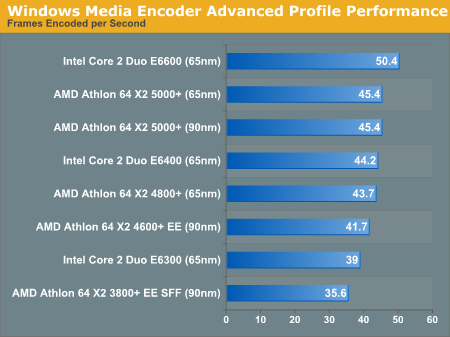

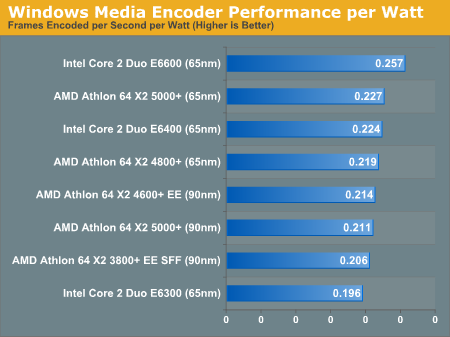
DivX performance favors Intel much more than our WME test, as the top three performance spots go to Intel. There's no performance difference between AMD's 90nm and 65nm chips in this test as both 5000+ CPUs are tied at 6.66 fps.
The absolute power advantage goes, once again, to the X2 3800+ EE SFF. Our 65nm 4800+ sample draws a bit less power than the 5000+ and even manages to draw less than the 90nm 4600+ EE. Unfortunately with no great power advantages and mid-range performance, the top three in the performance per watt category belong to Intel.
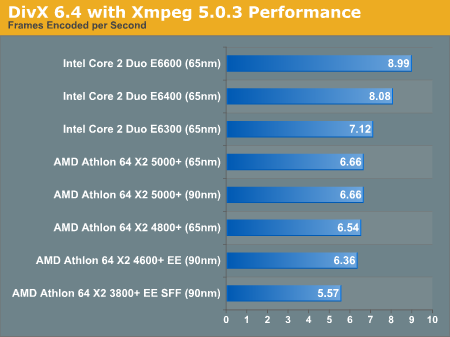
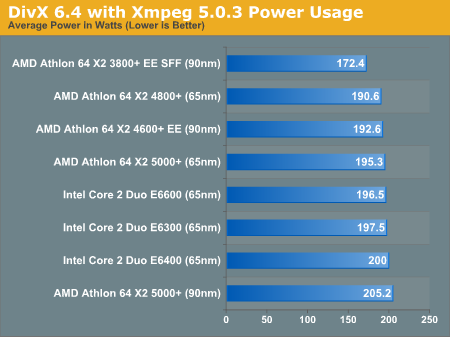
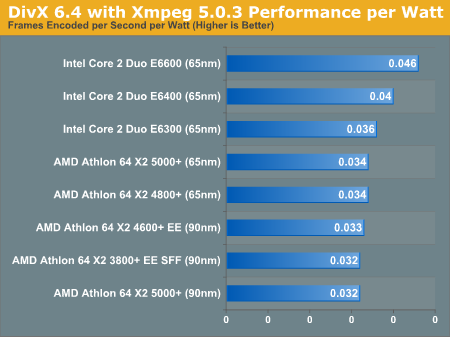










52 Comments
View All Comments
OcHungry - Wednesday, January 3, 2007 - link
I was wondering if there was a way to PM or email you.I would like to bring to your attention a few concerns regarding the forum and the moderators that you need to be aware of. Is there an email or can I PM you in any way?
I would appreciate your respond.
Bayad shoma bedaneed.
tashakore
SilverMirage - Saturday, December 23, 2006 - link
I understand that we are looking at limiting games by the CPU and not the graphics card, but lets be a little realistic...some of those performance per watt figures aren't what an end user is going to be seeing when comparing his options.Wwhat - Saturday, December 23, 2006 - link
Perhaps a weird thought but AMD bought that new ZRAM process that theoretically could put a huge cache on a small space with the flaw that it had so-so latency, then they later bought version 2 of the same but so far they didn't use it.Now what if this is an experiment with that technology, or a preamble, because at some time you would expect them to start using stuff they bought the license off, although at the time of the ZRAM announcement people were projecting use in a very far future that might not be what AMD has in mind, or the situation might have changed as to the performance of current versions of ZRAM.
What do you think, any link to it?
Tujan - Friday, December 22, 2006 - link
If you look,you'll see a story here in Anandtech.com for the first AMD X2s dated June 2005. The processor there was the 'top notch,for something unheard of in the processor industry. And even so doing with DDR400 memory.What is strange in these processor scenarios. There is Moores law. And there is the 'business quarter law. The article here,of wich I am commenting to,if the first of the detail in the "new processors"-the 65Nm processors. The AMDX2xs where also "new" when the 2005 articles was published. Today,as of reading this article,the "old"(and then top notch)is no longer being supported ..or as per use,no longer maintaining the subject cache sizes. AND well,point me if I am not correct,but the "old"processors are no longer going to be manufactured.
Well I have usually considered that in these events of "new,and old"technology that somehow,if something is 18 months past.I can actually afford it. This changes a little with the new Intel setups. Since the Intel lineups finally seem to break this cycle of the previous as I explained here.
For an entire year,I saw article after article,putting AMDs top notch as base line for performance. Ney user could address something of a culminating relationship to what had performance and what they could afford. And AMDs "top notch" an "industry standard" wich of course nobody could afford. At least if somebody was passing the buck,it wasn't happening with me.
Annyway,I would just like to say I wish AMD good luck.Yet I cannot be ashamed to say that I can now put together a system for less than 1000$ with the same parts as that '"top notch"industry standard seen for the permiating part of 2005.
Am I better for thinking that way ? 18 months passed,and my dollars are spendable but not supported ? I dont think that anybody could consider an AMD setup a 'low-end setup if for example the 4800+1Mb l2 can be had for 230$.
That is the enevitable consequence is the final exhaustion of the supply of the component. Yet I could say that I have a "top notch" 2005 version of AMD technology. With 2007 PARTS! Being on the exhausted end,I dont know who could feel better about this.
Wish AMD luck. Still with their record,I probably should say that I do not wish to look forward to exhaustion,at the same time as extingusishment,as in the mentioning of taking a break to what one pays for.
mino - Thursday, December 21, 2006 - link
Just my pint into the fire:X2 4200+EE & GF6150 board (MSI K9NGM2-FID)
$240 (170+75)
E6300 $ G965 board (ASUS P5B-VM)
$285 (185+100)
Conclusion:
Anything cheaper is K8 vs. Netburst so Intel is no contender.
Anything more expensive is K8 vs. C2D clock/clock so AMD is no contender (4800+65nm is more expensive than E6400 it matches by perf.)
For decent IGP-free boards the difference is comparable.
So, going for
stock performance the choice is simple:
<$300 for CPU+MB combo go AMD X2
>$300 for CPU+MB combo go Intel C2D
for overclocking:
<$240 for CPU+MB combo go AMD X2
$240-$285 -> wait and then Intel C2D
>$285 for CPU+MB combo go Intel C2D
for power consumption (i.e. PC's for office use):
AMD X2 3800+EE to 5000+EE (anything above or down is a waste of money in this case)
for single core:
<$190 for CPU + MB combo -> go AMD A64
$190-$230 for CPU + MB combo -> go AMD X2 at $240
>$240 see dual-core recommendations
That IMO sums up the whole Desktop PC market as of now.
mino - Thursday, December 21, 2006 - link
$190-$230 for CPU + MB combo -> go AMD X2 at $240should be:
$190-$230 for CPU + MB combo -> go AMD X2 3800+ at $200
mino - Thursday, December 21, 2006 - link
The prices are Newegg based.Shintai - Thursday, December 21, 2006 - link
Anand, can you test the 65nm K8 with lower res in games and a broader selection of games so we can more truely see the difference?http://www.firingsquad.com/hardware/amd_athlon_64_...">http://www.firingsquad.com/hardware/amd_athlon_64_...
If these numbers hold water, then 65nm K8s is a disaster in terms of gaming performance.
mongoosesRawesome - Thursday, December 21, 2006 - link
I'd be interested in seeing these same performance/watt graphs using the 965 chipset. The 680i is a power hog.mino - Thursday, December 21, 2006 - link
The same power hog is 590SLI for AMD.Actually 965 vs. RD580 would hurt Intel even more ... So, go figure.